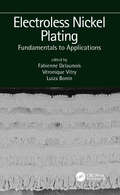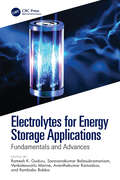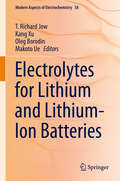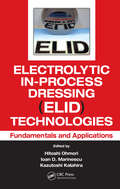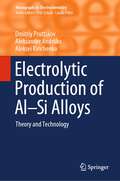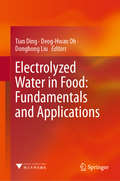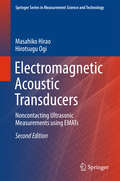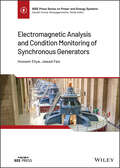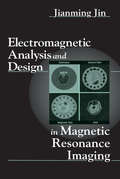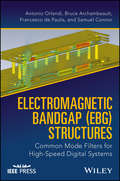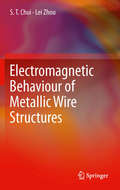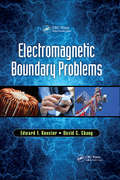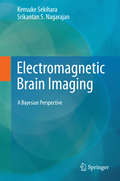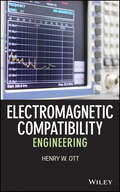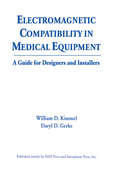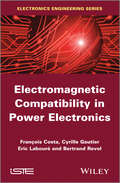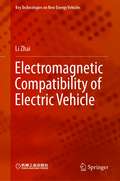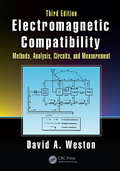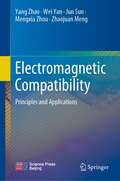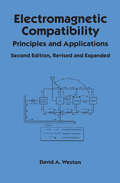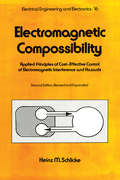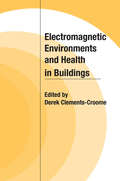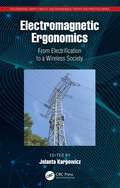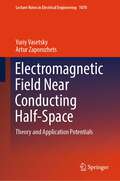- Table View
- List View
Electroless Nickel Plating: Fundamentals to Applications
by Fabienne Delaunois Veronique Vitry Luiza BoninElectroless Nickel Plating: Fundamentals to Applications provides a complete and actualized view of electroless nickel plating, thus greatly improving the accessibility of knowledge on the subject. It touches upon all aspects of electroless nickel, from the fundamentals (including thermodynamics of electroless plating, bath chemistry, and substrate preparation) to more applied areas of the field such as bath replenishment, composite coatings, post-treatments, polyalloys, graded and multilayer coatings, ultrasound assistance, applications, and properties. Contributed to by a variety of international authors to ensure different points of view and interests are addressed, this book stands as the first complete and updated state-of-the-art text on electroless nickel in the twenty-first century. It also serves as the first technical book with a strong emphasis on nickel-boron. It also focuses on environmental aspects. Including cutting-edge content presented sufficiently extensive to be directly useful to the practitioner, this book is aimed at materials scientists, metallurgists, and other professionals working with electroless nickel plating.
Electrolytes for Electrochemical Supercapacitors (Electrochemical Energy Storage and Conversion)
by Jiujun Zhang Jinli Qiao Cheng Zhong Yida Deng Wenbin Hu Daoming Sun Xiaopeng HanElectrolytes for Electrochemical Supercapacitors provides a state-of-the-art overview of the research and development of novel electrolytes and electrolyte configurations and systems to increase the energy density of electrochemical supercapacitors. Comprised of chapters written by leading international scientists active in supercapacitor research
Electrolytes for Energy Storage Applications: Fundamentals and Advances
by Ramesh K. Guduru Saravanakumar Balasubramaniam Venkateswarlu Manne Ananthakumar Ramadoss Rambabu BobbaThe book offers detailed progress and challenges in energy storage technologies with respect to various electrolyte chemistries including energy storage devices such as batteries and supercapacitors. It introduces energy storage systems and explains the selection of electrolytes for energy storage systems, aqueous- and non-aqueous-based electrolytes, metal-air batteries, and multivalent chemistries. Key features: Provides a better understanding of electrolytes for electrochemical energy storage devices Focuses on electrolytes and electrolytes valence Presents challenges and opportunities in energy storage systems Explains supercapacitors with respect to electrolyte systems Summarizes multivalent-based energy storage systems This book is written for graduate students and researchers in electrochemistry, physical chemistry, and renewable energy.
Electrolytes for Lithium and Lithium-Ion Batteries
by T. Richard Jow Kang Xu Oleg Borodin Makoto UeElectrolytes for Lithium and Lithium-ion Batteries provides a comprehensive overview of the scientific understanding and technological development of electrolyte materials in the last several years. This book covers key electrolytes such as LiPF6 salt in mixed-carbonate solvents with additives for the state-of-the-art Li-ion batteries as well as new electrolyte materials developed recently that lay the foundation for future advances This book also reviews the characterization of electrolyte materials for their transport properties, structures, phase relationships, stabilities, and impurities. The book discusses in-depth the electrode-electrolyte interactions and interphasial chemistries that are key for the successful use of the electrolyte in practical devices. The Quantum Mechanical and Molecular Dynamical calculations that has proved to be so powerful in understanding and predicating behavior and properties of materials is also reviewed in this book. Electrolytes for Lithium and Lithium-ion Batteries is ideal for electrochemists, engineers, researchers interested in energy science and technology, material scientists, and physicists working on energy.
Electrolytic In-Process Dressing (ELID) Technologies: Fundamentals and Applications
by Ioan D. Marinescu Hitoshi Ohmori Kazutoshi KatahiraEdited by experts, one of whom developed the technology, Electrolytic In-Process Dressing (ELID) Technologies: Fundamentals and Applications provides an overview of ELID processes with correlations between the main parameters, describes ELID operations, and illustrates the concepts with case studies. The book's authoritative coverage of major conce
Electrolytic Production of Al–Si Alloys: Theory and Technology (Monographs in Electrochemistry)
by Dmitriy Pruttskov Aleksander Andriiko Aleksei KirichenkoThis monograph presents the theoretical background of the industrial process for the production of Al-Si alloys in standard aluminum electrolyzers. It reviews the physical chemistry and electrochemistry of cryolite melts containing silica and focuses on analyzing the exchange reactions in Na3AlF6–Al2O3–SiO2 melts. It presents the kinetics and mechanism of Si(IV) electroreduction in Na3AlF6–Al2O3–SiO2 melts on Al cathodes while the current yields as well as industrial tests performed are discussed. The modern research trends in the field are also overviewed. Providing readers with information not easily obtained in any other single source, this book is of great interest to researchers, graduates, and professionals working in the fields of electrochemistry and technology of cryolite-based melts.
Electrolyzed Water in Food: Fundamentals And Applications
by Tian Ding Deog-Hwan Oh Donghong LiuThis book provides fundamentals, highlights recent developments and offers new perspectives relating to the use of electrolyzed water (EW) as an emerging user- and environmental-friendly broad-spectrum sanitizer, with particular focus on the food industry. It addresses the generation, inactivation, pesticide degradation and safety of food by EW, illustrates the mechanism of the germicidal action of EW and its antimicrobial efficacy against a variety of microorganisms in suspensions. In addition, the sanitizing effects of combining EW with various chemical and physical sanitizing technologies have been evaluated, and recent developments and applications of EW in various areas including fruits and vegetables, meat, aquatic products, environment sterilization, livestock and agriculture has been described. The book can be a go-to reference book of EW for: (1) Researchers who need to understand the role of various parameters in its generation, the bactericidal mechanism of EW and its wide applications for further research and development; (2) Equipment producers who need comprehensive understanding of various factors (e.g. type of electrolyte, flow rates of water and electrolyte) which govern the efficacy of EW and developing its generators; (3) Food processors who need good understanding of EW in order to implement it in the operations and supervisors who need to balance the advantages and limitations of EW and ensuring its safe use.
Electromagnetic Acoustic Transducers
by Masahiko Hirao Hirotsugu OgiThis second edition provides comprehensive information on electromagnetic acoustic transducers (EMATs), from the theory and physical principles of EMATs to the construction of systems and their applications to scientific and industrial ultrasonic measurements on materials. The original version has been complemented with selected ideas on ultrasonic measurement that have emerged since the first edition was released. The book is divided into four parts: PART I offers a self-contained description of the basic elements of coupling mechanisms along with the practical designing of EMATs for various purposes. Several implementations to compensate for EMATs' low transfer efficiency are provided, along with useful tips on how to make an EMAT. PART II describes the principle of electromagnetic acoustic resonance (EMAR), which makes the most of EMATs' contactless nature and is the most successful amplification mechanism for precise measurements of velocity and attenuation. PART III applies EMAR to studying physical acoustics. New measurements have emerged with regard to four major subjects: in situ monitoring of dislocation behavior, determination of anisotropic elastic constants, pointwise elasticity mapping (RUM), and acoustic nonlinearity evolution. PART IV deals with a variety of individual issues encountered in industrial applications, for which the EMATs are believed to be the best solutions. This is proven by a number of field applications.
Electromagnetic Analysis and Condition Monitoring of Synchronous Generators (IEEE Press Series on Power and Energy Systems)
by Jawad Faiz Hossein EhyaElectromagnetic Analysis and Condition Monitoring of Synchronous Generators Discover an insightful and complete overview of electromagnetic analysis and fault diagnosis in large synchronous generators In Electromagnetic Analysis and Condition Monitoring of Synchronous Generators, a team of distinguished engineers delivers a comprehensive review of the electromagnetic analysis and fault diagnosis of synchronous generators. Beginning with an introduction to several types of synchronous machine structures, the authors move on to the most common faults found in synchronous generators and their impacts on performance. The book includes coverage of different modeling tools, including the finite element method, winding function, and magnetic equivalent circuit, as well as various types of health monitoring systems focusing on the magnetic field, voltage, current, shaft flux, and vibration. Finally, Electromagnetic Analysis and Condition Monitoring of Synchronous Generators covers signal processing tools that can help identify hidden patterns caused by faults and machine learning tools enabling automated condition monitoring. The book also includes: A thorough introduction to condition monitoring in electric machines and its importance to synchronous generators Comprehensive explorations of the classification of synchronous generators, including armature arrangement, machine construction, and applications Practical discussions of different types of electrical and mechanical faults in synchronous generators, including short circuit faults, eccentricity faults, misalignment, core-related faults, and broken damper bar faults In-depth examinations of the modeling of healthy and faulty synchronous generators, including analytical and numerical methods Perfect for engineers working in electrical machine analysis, maintenance, and fault detection, Electromagnetic Analysis and Condition Monitoring of Synchronous Generators is also an indispensable resource for professors and students in electrical power engineering.
Electromagnetic Analysis and Design in Magnetic Resonance Imaging (Biomedical Engineering Ser. #1)
by Jianming JinThis book presents a comprehensive treatment of electromagnetic analysis and design of three critical devices for an MRI system - the magnet, gradient coils, and radiofrequency (RF) coils. Electromagnetic Analysis and Design in Magnetic Resonance Imaging is unique in its detailed examination of the analysis and design of the hardware for an MRI system. It takes an engineering perspective to serve the many scientists and engineers in this rapidly expanding field.Chapters present:an introduction to MRIbasic concepts of electromagnetics, including Helmholtz and Maxwell coils, inductance calculation, and magnetic fields produced by special cylindrical and spherical surface currentsprinciples for the analysis and design of gradient coils, including discrete wires and the target field method analysis of RF coils based on the equivalent lumped-circuit model as well as an analysis based on the integral equation formulationsurvey of special purpose RF coilsanalytical and numerical methods for the analysis of electromagnetic fields in biological objectsWith the continued, active development of MRI instrumentation, Electromagnetic Analysis and Design in Magnetic Resonance Imaging presents an excellent, logically organized text - an indispensable resource for engineers, physicists, and graduate students working in the field of MRI.
Electromagnetic Bandgap (EBG) Structures: Common Mode Filters for High Speed Digital Systems
by Samuel Connor Antonio Orlandi Bruce Archambeault Francesco De PaulisAn essential guide to the background, design, and application of common-mode filtering structures in modern high-speed differential communication links Written by a team of experts in the field, Electromagnetic Bandgap (EBG) Structures explores the practical electromagnetic bandgap based common mode filters for power integrity applications and covers the theoretical and practical design approaches for common mode filtering in high-speed printed circuit boards, especially for boards in high data-rate systems. The authors describe the classic applications of electromagnetic bandgap (EBG) structures and the phenomena of common mode generation in high speed digital boards. The text also explores the fundamental electromagnetic mechanisms of the functioning of planar EBGs and considers the impact of planar EBGs on the digital signal propagation of single ended and differential interconnects routed on top or between EBGs. The authors examine the concept, design, and modeling of EBG common mode filters in their two forms: on-board and removable. They also provide several comparisons between measurement and electromagnetic simulations that validate the proposed EBG filters' design approach. This important resource: • Presents information on planar EBG based common mode filters for high speed differential digital systems • Provides systematic analysis of the fundamental mechanisms of planar EBG structures • Offers detailed design methodology to create EBG filters without the need for repeated full-wave electromagnetic analysis • Demonstrates techniques for use in practical real-world designs Electromagnetic Bandgap (EBG) Structures: Common Mode Filters for High Speed Digital Systems offers an introduction to the background, design, and application of common-mode filtering structures in modern high-speed differential communication links, a critical issue in high-speed and high-performance systems.
Electromagnetic Behaviour of Metallic Wire Structures
by Lei Zhou S. T. ChuiDespite the recent development and interest in the photonics of metallic wire structures, the relatively simple concepts and physics often remain obscured or poorly explained to those who do not specialize in the field. Electromagnetic Behaviour of Metallic Wire Structures provides a clear and coherent guide to understanding these phenomena without excessive numerical calculations. Including both background material and detailed derivations of the various different formulae applied, Electromagnetic Behaviour of Metallic Wire Structures describes how to extend basic circuit theory relating to voltages, currents, and resistances of metallic wire networks to include situations where the currents are no longer spatially uniform along the wire. This lays a foundation for a deeper understanding of the many new phenomena observed in meta-electromagnetic materials. Examples of applications are included to support this new approach making Electromagnetic Behaviour of Metallic Wire Structures a comprehensive and self-contained volume suitable for use by specialists, non-specialist, researchers and professionals in other relevant fields and even students.
Electromagnetic Boundary Problems
by Edward F. Kuester David C. ChangElectromagnetic Boundary Problems introduces the formulation and solution of Maxwell's equations describing electromagnetism. Based on a one-semester graduate-level course taught by the authors, the text covers material parameters, equivalence principles, field and source (stream) potentials, and uniqueness, as well as:Provides analytical solutions
Electromagnetic Brain Imaging
by Kensuke Sekihara Srikantan S. NagarajanThis graduate level textbook provides a coherent introduction to the body of main-stream algorithms used in electromagnetic brain imaging, with specific emphasis on novel Bayesian algorithms. It helps readers to more easily understand literature in biomedical engineering and related fields and be ready to pursue research in either the engineering or the neuroscientific aspects of electromagnetic brain imaging. This textbook will not only appeal to graduate students but all scientists and engineers engaged in research on electromagnetic brain imaging.
Electromagnetic Compatibility Engineering
by Henry W. OttPraise for Noise Reduction Techniques IN electronic systems"Henry Ott has literally 'written the book' on the subject of EMC. . . . He not only knows the subject, but has the rare ability to communicate that knowledge to others."--EE TimesElectromagnetic Compatibility Engineering is a completely revised, expanded, and updated version of Henry Ott's popular book Noise Reduction Techniques in Electronic Systems. It reflects the most recent developments in the field of electromagnetic compatibility (EMC) and noise reduction¿and their practical applications to the design of analog and digital circuits in computer, home entertainment, medical, telecom, industrial process control, and automotive equipment, as well as military and aerospace systems.While maintaining and updating the core information--such as cabling, grounding, filtering, shielding, digital circuit grounding and layout, and ESD--that made the previous book such a wide success, this new book includes additional coverage of:Equipment/systems groundingSwitching power supplies and variable-speed motor drivesDigital circuit power distribution and decouplingPCB layout and stack-upMixed-signal PCB layoutRF and transient immunityPower line disturbancesPrecompliance EMC measurementsNew appendices on dipole antennae, the theory of partial inductance, and the ten most common EMC problemsThe concepts presented are applicable to analog and digital circuits operating from below audio frequencies to those in the GHz range. Throughout the book, an emphasis is placed on cost-effective EMC designs, with the amount and complexity of mathematics kept to the strictest minimum.Complemented with over 250 problems with answers, Electromagnetic Compatibility Engineering equips readers with the knowledge needed to design electronic equipment that is compatible with the electromagnetic environment and compliant with national and international EMC regulations. It is an essential resource for practicing engineers who face EMC and regulatory compliance issues and an ideal textbook for EE courses at the advanced undergraduate and graduate levels.
Electromagnetic Compatibility in Medical Equipment: A Guide for Designers and Installers
by William D. Kimmel Daryl GerkeCo-published with the IEEE Press, this book is a practical, hands-on guide to EMC issues for medical device designers and installers. It addresses electromagnetic interference and covers the basics of EMC design, physics, and installation, minimizing theory and concentrating upon the correct way to ground and shield. Covering EMC from the inside out, the book provides the basics of electronics, discusses and evaluates problems and common causes, and explores effective remedial techniques at three levels: circuit, box, and interconnect. It contains appendices that provide important reference material such as constants and conversion factors.
Electromagnetic Compatibility in Power Electronics (Wiley-iste Ser.)
by Eric Laboure Bertrand Revol François CostaScientists largely attribute the recent deterioration of the electromagnetic environment to power electronics. This realization has spurred the study of methodical approaches to electromagnetic compatibility designs as explored in this text. The book addresses major challenges, such as handling numerous parameters vital to predicting electro magnetic effects and achieving compliance with line-harmonics norms, while proposing potential solutions.
Electromagnetic Compatibility of Electric Vehicle (Key Technologies on New Energy Vehicles)
by Li ZhaiThis book introduces the electromagnetic compatibility(EMC) of electric vehicle(EV), including EMC of the whole vehicle, electromagnetic interference(EMI) prediction and suppression of motor drive system, EMI prediction and suppression of DC-DC converter, electromagnetic field safety and EMC of wireless charging system, signal integrity and EMC of the vehicle controller unit(VCU), EMC of battery management system(BMS), electromagnetic radiated emission diagnosis and suppression of the whole vehicle, etc. The analysis method, modeling and simulation method, test method and rectification method of EMC are demonstrated. The simulation and experimental results are presented as tables and figures. This book is useful as reference for graduate students, senior undergraduates and engineering technicians of vehicle engineering related majors. For EMI prediction, suppression and EMC optimization design for EVs, this book provides reference for engineers to solve EMC problems. This book is intended for senior undergraduates, postgraduates, lecturers and laboratory researchers engaged in electric vehicle and electromagnetic compatibility research.
Electromagnetic Compatibility: Methods, Analysis, Circuits, and Measurement, Third Edition
by David A. WestonRevised, updated, and expanded, Electromagnetic Compatibility: Methods, Analysis, Circuits, and Measurement, Third Edition provides comprehensive practical coverage of the design, problem solving, and testing of electromagnetic compatibility (EMC) in electrical and electronic equipment and systems. This new edition provides novel information on theory, applications, evaluations, electromagnetic computational programs, and prediction techniques available. With sixty-nine schematics providing examples for circuit level electromagnetic interference (EMI) hardening and cost effective EMI problem solving, this book also includes 1130 illustrations and tables. Including extensive data on components and their correct implementation, the myths, misapplication, misconceptions, and fallacies that are common when discussing EMC/EMI will also be addressed and corrected.
Electromagnetic Compatibility: Principles and Applications
by Yang Zhao Wei Yan Jun Sun Mengxia Zhou Zhaojuan MengThis book highlights principles and applications of electromagnetic compatibility (EMC). After introducing the basic concepts, research progress, standardizations and limitations of EMC, the book puts emphasis on presenting the generation mechanisms and suppression principles of conducted electromagnetic interference (EMI) noise, radiated EMI noise, and electromagnetic susceptibility (EMS) problems such as electrostatic discharge (ESD), electric fast transient (EFT) and surge. By showing EMC case studies and solved examples, the book provides effective solutions to practical engineering problems. Students and researchers will be able to use the book as practical reference for EMC-related measurements and problem- solution.
Electromagnetic Compatibility: Principles and Applications, Second Edition, Revised and Expanded (Electrical and Computer Engineering #Vol. 73)
by David WestonThis totally revised and expanded reference/text provides comprehensive, single-source coverage of the design, problem solving, and specifications of electromagnetic compatibility (EMC) into electrical equipment/systems-including new information on basic theories, applications, evaluations, prediction techniques, and practical diagnostic options for preventing EMI through cost-effective solutions.Offers the most recent guidelines, safety limits, and standards for human exposure to electromagnetic fields!Containing updated data on EMI diagnostic verification measurements, as well as over 900 drawings, photographs, tables, and equations-500 more than the previous edition-Electromagnetic Compatibility: Principles and Applications, Second Edition:
Electromagnetic Compossibility, Second Edition,
by Heinz M. SchlickeThis book addresses one of the most pressing, controversial, and misunderstood areas of electrical engineering: the cost-effective prevention of electromagnetic interference and hazards in automated industrial systems. It focuses on civilian noncommunication environment.
Electromagnetic Environments and Health in Buildings
by Derek Clements-CroomeWith increasing use of mobile phones and VDUs, levels of background radiation and electromagnetism are rising, particularly in the workplace and also in the home. To some extent this is unavoidable, but the level of dangers is unclear: is it trivially small, moderate or high? What are the risks of illness, and how can these be reduced to minimal or tolerable levels? Are some people more vulnerable than others? What can or should employers, building engineers and designers, product designers, workers and other members of the public do?This book, of which the chapters derive from presentations given by distinguished authorities at a major international conference, aims to present sound technical information on the whole range of key issues in a clear and accessible way.
Electromagnetic Ergonomics: From Electrification to a Wireless Society (Occupational Safety, Health, and Ergonomics)
by Jolanta KarpowiczErgonomics is the branch of engineering science in which biological science is used to study the relationship between workers and their environments. Because of the use of electricity for many purposes, one environmental factor that has become omnipresent today is the electromagnetic field, also referred to as electromagnetic radiation or a fraction of the non-ionizing radiation. The complex interactions of electromagnetic energy with material objects contribute to ergonomics issues because they can cause health hazards in workers, trigger accidental situations, limit the ability of workers to work safely and disturb the function of electronic devices, including medical implants, etc. A better understanding of complex electromagnetic issues in the work environment is considered in this book. This title will be beneficial to workers affected by electromagnetic hazards including wireless transfer of information or power, wireless (induction) heating, joining metal elements with electric-supplied techniques, capacitive heating of dielectric materials, physiotherapeutic or cosmetic electromagnetic treatments, antitheft gates and other monitoring or control systems using wireless solutions, electric transportation and many more. It will help prevent common misunderstandings about electromagnetic hazards and sufficiently reduce where they appear. Electromagnetic Ergonomics is designed to have a positive influence on public health and worker safety in the work environment and brings broad benefits, in particular with respect to research planning and the interpretation of the results, as well as the implementation of science-based evidence regarding the evaluation and elimination of EMF hazards in the operations of enterprises and environmental, labor and sanitary inspections, as well as government regulators responsible for environmental safety issues in the workplace and the daily life environment.
Electromagnetic Field Near Conducting Half-Space: Theory and Application Potentials (Lecture Notes in Electrical Engineering #1070)
by Artur Zaporozhets Yuriy VasetskyThe book is devoted to the solution of one general problem of the theory of a three-dimensional quasi-stationary sinusoidal and pulse electromagnetic field. These studies, unlike many well-known works, are based on obtained exact analytical solution of the problem for the field, generated by external current sources near the conducting body with plane surface. The solution for the vector and scalar potentials, electric and magnetic intensities in the dielectric and conducting media is found without restrictions on the configuration of current sources,properties of the media and field frequency. Some general properties of field formation for arbitrary field in the considered system are obtained (in particular, full compensation by the field of the electric charge distributed on the interface between the media, the normal component of the induced external electric field and, accordingly, the equality to zero the components both of the current density and the electric field intensity perpendicular to the interface; the non-uniform electromagnetic field decreases in depth of conducting medium faster than uniform field). It is shown that the exact analytical solution depends on the values of the parameter proportional to the ratio of the field penetration depth to the distance between the external field sources and the body. The concept of strong skin effect is extended to the case of small value of the introduced parameter. A significant simplification of theexpressions was obtained as an asymptotic expansion on this small parameter. In the case of pulsed fields approximate method gives the highest accuracy during important initial period of pulse time. For asymptotic expansion the approximate impedance boundary condition is generalized to the diffusion of non-uniform field into conducting medium. The book is intended for the researchers, postgraduate students and students specialized in theory and calculations of electromagnetic fields.
